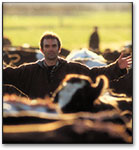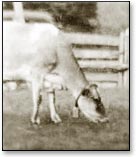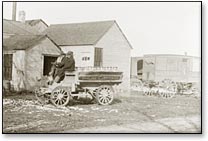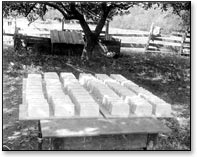Dairy work included milking, making cream and butter, and also the sophisticated art of making cheese. In Europe it was always done by women. The word "dairy" is from Middle English dey ‑ a female servant. The dairy was associated with the house as opposed to the lands; "inside" has always been female in the Western imagination, and "outside" male, so that the man's place was in the public eye while the woman's was at home. Also, milk was perhaps considered self‑evidently a woman's affair.
History records that a primary object of keeping cows was to supply the needs of the family for milk and butter. Butter was produced almost universally in olden times because it was more essential in the diet of most people, although it was several centuries before the consumption of fresh butter became established custom. The art of making butter, therefore, originated in the home.
As communities expanded and frontiers were pushed back with the growth of nations, many families were gradually forced to procure their supplies of milk and butter from farmers located in their vicinity. Then, as populations became more congested, and as cities sprang up, butter making on farms became more and more important. As our larger cities developed, important tracing areas also developed resulting eventually in the establishment of Boards of Trade and later in Mercantile Exchanges in New York and Chicago, for example.
The farm production of butter began to assume definite shape at least as early as 1791 as Willard stated in 1871 that "Orange County located 50 miles north of New York City had for 80 years devoted its chief attention to butter making and the production of fresh milk for the New York City Market." "Dairy butter," as this product made on the farm was called, made up for sale was oftentimes collected as "pats," "balls," "rolls" and even "prints."
|
|
This was particularly true in the Philadelphia market which long enjoyed high reputation for fine dairy butter. It was not uncommon for such "Philadelphia butter" to sell at a dollar per pound and even higher where the prevailing market prices were around 20 cents per pound or less. This fine Philadelphia butter was defined as:
"Our idea is that butter -- such butter as would give a man an appetite to look at, to smell of and taste of -- is as far removed from an oily, fatty, or tallowy substance as possible... a firm, fine- grained article, of rich golden color, sweet, nutty aromatic smell and unctuous taste, put up in pound or half-pound lumps, whether square or round, and which, when opened out from its moist, then white linen wrapper, invites both the senses of smell and taste."
In the late 19th century, marketing butter was thought to be the easiest part of the whole process, or the least important, judging by the manner in which it was done. If the maker was near a market, it was often put into half-pound or pound lumps, and printed or stamped with some emblematic device, such as a sheaf of wheat, a cow, a beehive, or the maker's initials. After the final working, a lump is cut off with the clapper, placed upon the scales, and either added to or taken from, always being sure to give rather over than under a pound. It is then taken from the scale by one clapper (roughly a spoon) in the right hand, and with the other clapper in the left, it is worked over into a ball by a few expert touches; and while held on the left-hand clapper, the right-hand one having been exchanged for the stamp-mould is dipped in cold water to prevent its sticking to the lump, and then pressed firmly upon it, then withdrawn, leaving a beautiful raised impression of the stamp upon it, and adding to its attractions.
The fashion was to make the lumps square, which was more convenient for use and for packing in the market tray. When it was all stamped, it was set aside in a cold place to thoroughly harden; in a tray in the spring-house water was best. When about to market it, each pound or roll was wrapped in a linen cloth taken out of ice water or cold spring water, and laid upon the shelf of the tray or tub. In the winter, the butter was often kept in a square box with a sliding lid and several shelves. In the summer, it was common to have a large tub made of cedar, with an inner tin vessel, with a well in each end for broken ice, an oil cloth covering, and shelves on each side of them on which the butter was placed, and was removed as it was sold.
Refrigeration was not common. Beginning in 1806, Boston traders conducted extensive commerce in enormous blocks of Arctic ice, towed to destinations all over the Atlantic world. In 1851, the first refrigerated rail car, cooled by natural ice, brought butter from Ogdensburg, New York, to Boston. Ice, however, remained, in most of the world, an expensive commodity, which could never be the basis of industrial freezing. The solution was the compressed-gas cooler, perfected in Australia in the 1870s (for brewing), and later used worldwide.
The linen wrappers or napkins used in the Philadelphia market for covering the print butter were often washed, ironed and returned by customers to the dealers in their market stalls. In other areas, the rolls, pats, or prints produced on dairy farms for sale were wrapped in freshly laundered pieces of cloth rags of either white or colored and printed fabrics which lead to the adoption of that rather descriptive term -- "shirt-tail wrappers." Cheesecloth was early adopted as an economical wrapper in the place of the linen wrappers or napkins used in Philadelphia and later replaced with a "butter" or "dairy cloth" made expressly for the purpose of wrapping rolls, pats and prints.
|
|
In the 1880's and 1890's, paraffin paper later replaced by vegetable parchment were used as wrappers in place of the various cloth fabrics. It might be mentioned in passing, however, that Hazard was not unaware of the possibilities of paper as a wrapper, for in his text can be found a statement relative to keeping butter fresh, which reads as follows:
"...it is then wrapped in clean white paper which has been coated on both sides with a preparation of white of egg and fifteen grains of salt to each egg, the paper then dried, and heated before the fire, or with a hot iron just before it is applied to the rolls of butter."
Concerning the molding and packing of butter in California in 1870, butter was sent to market in barrels, half-barrels and in two-pound rolls placed in packages. The rolls were made three inches in diameter and nearly seven inches long. A mold used for the purpose of forming these rolls had two iron handles crossing each other on a pivot and used similarly to a pair of nippers. By applying pressure on the two handles, butter was compressed in the mold into a solid roll. The roll was smoothed by rolling with a wooden paddle following which each roll of butter was wrapped in cloth. Fine cambric cloth cut in strips long enough to surround the roll and wide enough to leave about one-half inch of cloth at each end served as the wrapper. The wrapped rolls were then set on end in an oblong box of either cedar or redwood and securely held in place with the cover fastened down. Such rolls were supplied the San Francisco market.
In 1877 Vermont, if the butter was to be packed into tubs, it was best not to put in small pieces at a time and pound it in, but rig up a lever and put in enough to half fill the tub at a time, and press it firmly down. This would retain the grain of the butter. The butter maker would put the butter up in pound prints. Not using a mold -- it gave the butter a dull look. They would press it into the form of a brick with a stout paddle, and press cross lines on one side with the edge of the paddle. Each pound would be wrapped in a piece of white cloth. Print butter would be shipped in a neat clean package, nicely painted on the outside. In 1894, the "World's Largest Creamery" was located at St. Albens, Vermont which was reputed to have made 25,000 pounds of butter daily.





